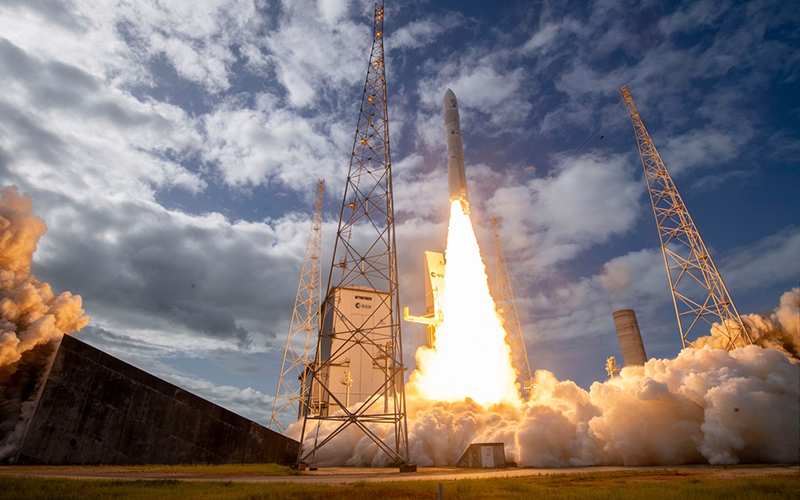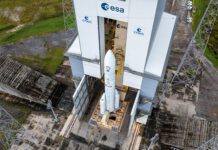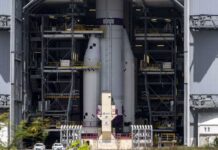
During the inaugural flight of Europe’s Ariane 6 rocket, an anomaly occurred, resulting in two of the mission’s payloads not being deployed successfully.
The inaugural Ariane 6 mission was launched on 9 July at 21:00 CEST from the Guiana Space Centre. Just over one hour into the flight, three payload separation events were successfully performed over a period of just nine seconds. A fourth and final payload separation event was then expected to occur almost fours after liftoff following a deorbit burn that would put the rocket’s upper stage on a trajectory to burn up in Earth’s atmosphere. The two payloads were small re-entry capsules that could not perform their own deorbit burn, thus the unusual deployment sequence.
Just before a mission’s two-hour mark, it became clear that the rocket’s upper stage had deviated from its planned mission profile, failing to raise its altitude. The ESA broadcast commentators confirmed the deviation, citing an issue with the second Auxiliary Power Unit (APU) power-up.
The APU is used to pressurize the rocket’s upper stage tanks to allow for in-orbit Vinci engine restarts, ensuring consistent fuel delivery. Additionally, the APU provides a small amount of thrust, contributing to the maneuverability and precision of the rocket during its mission.
Two hours and fifty minutes into the flight, ESA concluded its mission broadcast with it clear that a final deorbit burn had not been succesfully completed.
During a post-launch press conference, ArianeGroup CEO Martin Sion revealed that the APU had initially powered up before abruptly stopping. Without the APU, the rocket was not able to restart its Vinci engine for a second time to complete a deorbit burn. Sion added that the stage’s passivation was triggered successfully. Passivation refers to the process of removing stored energy from a vehicle to reduce the risk of high-energy releases (explosions or fragmentations, for example) that could produce unwanted orbital debris.
In a November 2021 post, ArianeGroup stated that an example of APU’s versatility was “its ability to de-orbit the stage at the end of a mission in accordance with European space law by powering it towards Earth, so that it burns up on atmospheric entry.” Despite this, Sion did not appear to think that the failure to deorbit the mission’s upper stage was all that significant.
“What is clear is that there are a lot of upper stages that are still orbiting and take several years to go back, depending on the orbit. So it’s not a unique situation.” He went on to add, “This is something which does not create more hazard than what happens with the vast majority of launchers.”
Sion attempted to further downplay the impact of the anomaly, stating that it had occurred during a “demonstration phase” of the mission. According to the ArianeGroup CEO, this phase of the mission was intended to examine how the upper stage behaved in microgravity and how the different systems operate in this environment.
“This is why, from the beginning, we were very clear on the fact that there were two aspects. One was to demonstrate the launcher’s success, which we did. And then to understand and to and gather as much information as possible in this microgravity phase.”
While European Spaceflight can not confirm without a doubt that this differentiation was not made clear “from the beginning,” what is clear is that ESA’s official mission kit, which was published prior to the launch, does not distinguish between the two phases of the mission described by Sion. The mission’s “Launch Timeline” also does not outline different phases of the flight.
What’s next for Ariane 6?
According to ESA, data from different ground stations detailing how the upper stage performed will first need to be collated before an analysis of the data can begin. This process is expected to take a few days, and the subsequent analysis to determine what happened to the APU will take between one and two weeks.
Despite not yet understanding what happened to the APU during the inaugural flight, Arianespace CEO Stephane Israel confirmed that the investigation would have no impact on the rocket’s first operational launch, which is expected before the end of 2024.
“We are perfectly on track now to make the second launch this year,” said Israel. “It has no consequence on the next launches.”
This is likely partially true. ArianeGroup has proven that Ariane 6 can successfully complete a standard mission profile. This has allowed the company to move forward with the rocket’s next flight, which is expected to carry a French spy satellite to orbit. However, the rocket may continue to not be able to complete a deorbit burn until the problem with the APU can be fully understood.




